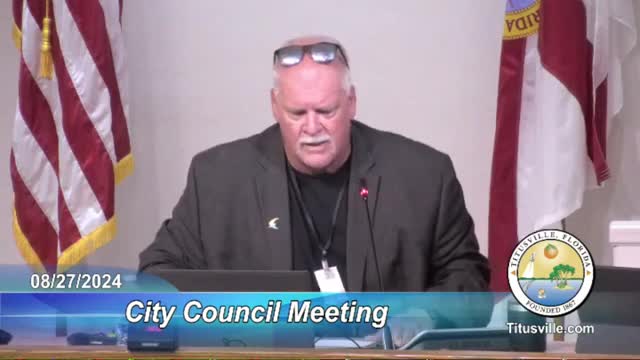City Council Debates Landscape Design Amid Safety Concerns
August 28, 2024 | Titusville, Brevard County, Florida
This article was created by AI summarizing key points discussed. AI makes mistakes, so for full details and context, please refer to the video of the full meeting. Please report any errors so we can fix them. Report an error »

During a recent government meeting, city officials engaged in a detailed discussion regarding the landscaping plans for key entryways into the city, particularly focusing on the use of palm trees and the potential for redesigning the project. The conversation highlighted the reliance on landscape architects for planning, as the city lacks an urban forestry division and landscape architects on staff.
Concerns were raised about the appropriateness of planting large hardwood trees along roads with speed limits of 45 miles per hour, as they could pose traffic hazards. Officials noted that the Department of Transportation (DoT) would likely restrict such plantings. The discussion also touched on the maintenance of landscaped areas, with officials acknowledging that maintaining these spaces requires significant resources, including full-time staff and contracted services.
Council member Nelson expressed a desire to reconsider the use of palm trees, citing potential future problems related to palm tree diseases. He suggested tabling the decision to allow for further consultation with DoT and to explore alternative landscaping options that would be easier to maintain and more resilient over time. Other council members echoed this sentiment, emphasizing the importance of creating an aesthetically pleasing entryway that residents could take pride in.
The council ultimately agreed to table the decision for further investigation into the types of trees that could be used, including native species, and to assess the feasibility of preventing diseases that affect palm trees. The city staff was tasked with reaching out to the landscape designer and DoT to clarify the flexibility of the current plans and to gather more information on suitable plant options.
This meeting underscores the city's commitment to thoughtful urban planning and community engagement, as officials seek to balance aesthetic considerations with safety and maintenance concerns.
Concerns were raised about the appropriateness of planting large hardwood trees along roads with speed limits of 45 miles per hour, as they could pose traffic hazards. Officials noted that the Department of Transportation (DoT) would likely restrict such plantings. The discussion also touched on the maintenance of landscaped areas, with officials acknowledging that maintaining these spaces requires significant resources, including full-time staff and contracted services.
Council member Nelson expressed a desire to reconsider the use of palm trees, citing potential future problems related to palm tree diseases. He suggested tabling the decision to allow for further consultation with DoT and to explore alternative landscaping options that would be easier to maintain and more resilient over time. Other council members echoed this sentiment, emphasizing the importance of creating an aesthetically pleasing entryway that residents could take pride in.
The council ultimately agreed to table the decision for further investigation into the types of trees that could be used, including native species, and to assess the feasibility of preventing diseases that affect palm trees. The city staff was tasked with reaching out to the landscape designer and DoT to clarify the flexibility of the current plans and to gather more information on suitable plant options.
This meeting underscores the city's commitment to thoughtful urban planning and community engagement, as officials seek to balance aesthetic considerations with safety and maintenance concerns.
View full meeting
This article is based on a recent meeting—watch the full video and explore the complete transcript for deeper insights into the discussion.
View full meeting